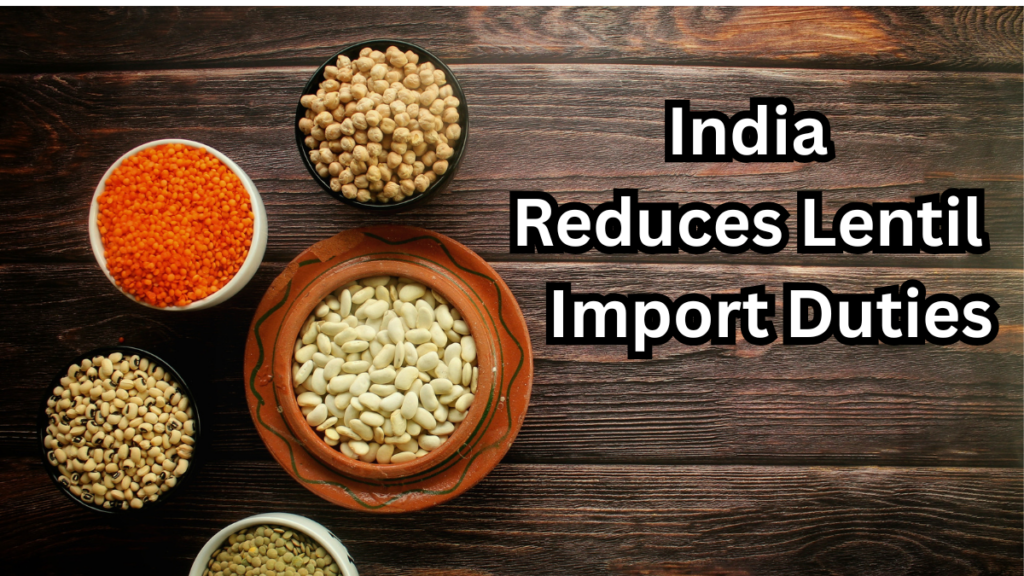India’s agricultural sector has witnessed a significant change with the reduction of import duties on lentils. This move is expected to reshape trade dynamics and offer new opportunities for both India and its international trade partners. The key suppliers—Canada, the U.S., and Australia—stand to benefit from this policy shift, as it promises to improve lentil availability and affordability in the country. Let’s take a closer look at how this change impacts India’s agricultural economy, trade relationships, and the broader global market.

Why Lentils Matter to India’s Agricultural Economy
Lentils are a staple in many Indian households, especially in vegetarian communities, providing an essential source of protein. India is both the world’s largest consumer and one of the largest importers of lentils. The domestic supply of lentils, however, faces challenges due to various factors:
-
Unpredictable weather patterns impacting production.
-
Pest infestations reducing crop yields.
-
Farmers’ shifting priorities, often moving away from lentil cultivation.
Given these challenges, India has turned to major lentil exporters—like Canada, Australia, and the U.S.—to meet domestic demand.
Key Aspects of the Trade Concessions
India’s decision to reduce import duties on lentils from major suppliers like Canada, the U.S., and Australia is a significant policy shift aimed at stabilizing the market and ensuring affordable lentil prices. Here’s a breakdown of the key elements of the trade concessions:
1. Reduction in Import Duties
Historically, India imposed high tariffs on lentils to protect domestic farmers. However, with the rising demand for affordable pulses, India has reduced these tariffs to make lentils more accessible for consumers.
-
Canada remains a dominant supplier, and this reduction will likely increase the flow of Canadian lentils into India.
2. Bilateral Trade Agreement (BTA)
The trade concessions are part of a broader Bilateral Trade Agreement (BTA) with countries like Canada, Australia, and the U.S. This agreement aims to:
-
Provide access to affordable agricultural products.
-
Foster economic ties through improved trade relations.
3. Incentives for Importers and Farmers
India has introduced incentives to encourage more competition in the retail market, ensuring lentils are accessible, particularly to low-income families. This is a welcome move for those most affected by rising food prices.
4. Sustainability in Agriculture
With increased imports from countries with advanced farming technologies, India also has the opportunity to adopt sustainable farming practices. This could lead to long-term improvements in domestic production and reduce future dependence on imports.
Broader Impact of the Trade Changes
The reduction in import duties will not only affect India’s local markets but also ripple through the global agricultural sector.
1. Impact on Domestic Farmers and Local Markets
-
Increased competition: While this move benefits consumers by lowering prices, Indian farmers may face increased competition from cheaper imported lentils.
-
Government support: The Indian government has pledged support through subsidies, access to modern farming tools, and training for local farmers.
2. Boost to Global Pulse Trade
India’s reduced tariffs on lentils will increase demand for pulses globally, especially from Canada, Australia, and the U.S. Countries that export lentils will likely see a surge in shipments to India.
3. Strengthened Bilateral Relations
This move enhances India’s trade relationships with pulse-exporting countries, which could pave the way for additional trade agreements in sectors like pharmaceuticals, technology, and energy.
4. Impact on Global Trade Agreements
India’s trade changes could influence global trade norms, especially within the World Trade Organization (WTO), as other developing nations may request similar tariff reductions for better access to India’s market.
Potential Challenges and Concerns
While the trade changes present opportunities, they come with certain challenges that India must address:
1. Long-Term Sustainability of Trade Policy
-
Balancing act: As domestic production stabilizes, India will need to find a balance between supporting local farmers and maintaining affordable food prices.
2. Dependency on Foreign Imports
-
Risks of over-reliance: While imports help meet the demand, heavy reliance on foreign sources could be risky, especially during global supply disruptions.
3. Environmental and Sustainability Concerns
-
Carbon footprint: The environmental impact of long-distance transportation of lentils from international suppliers must be considered, with sustainable practices being a priority.
Conclusion:
India’s reduction of import duties on lentils is a strategic step to ensure affordable access to pulses while fostering stronger trade relationships with key partners like Canada, Australia, and the U.S. However, to ensure long-term sustainability, India must carefully navigate the balance between supporting domestic farmers and managing its reliance on imported lentils. The government’s commitment to sustainable agricultural practices and innovation in farming technology could help stabilize the domestic market and create a more resilient agricultural economy.
Frequently Asked Questions (FAQs)
1. How will reducing import duties on lentils benefit Indian consumers?
The reduction in import duties will lower the cost of lentils, making them more affordable for Indian consumers. This is especially beneficial for low-income households that rely on pulses as a primary protein source.
2. Which countries will benefit most from India’s new trade concessions?
Countries like Canada, the U.S., and Australia, which are major exporters of lentils, will see an increase in their shipments to India due to the reduced import tariffs.
3. How will Indian farmers be affected by the reduced tariffs on lentils?
Indian farmers may face competition from cheaper imported lentils, potentially impacting their income. However, the Indian government plans to offer subsidies and support to ensure that local farmers are not adversely affected.
4. What long-term impact could this policy have on India’s agricultural economy?
In the long term, India could benefit from adopting more sustainable agricultural practices, improving domestic lentil production, and reducing dependency on imports. This could help stabilize prices and ensure food security.
